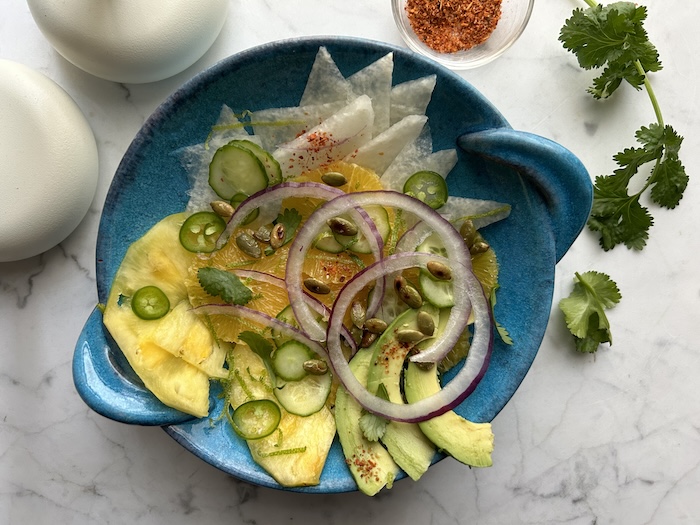One summer day several years back, I sat down for lunch at an outdoor table with a handful of young men from Mexico and Ecuador. They were passing around a plastic bottle of orange powder, sprinkling its contents liberally on their pineapple and watermelon wedges, on their avocado slices and on their green salads. When I asked about it, they told me it was Tajin, a mixture of lime zest, sea salt and chili pepper, adding that they’d brought several bottles with them in their duffel bags when they’d come to Vermont to work for the summer.
The moment I tried it, I could see why they’d bothered. The citrus and chili add a pop of brightness, while the hint of salt releases and intensifies the natural aromas of fresh fruits and vegetables.
In those days it was part of my job to manage the food ordering and inventories for seven summer camp kitchens, including the one that had just served lunch to this group, and I confess I felt a surge of self-reproach at the thought that they’d had to lug this condiment roughly 2,000 miles when I ought to have figured out a way to order it for them instead. The next day, I found a supplier and distributed a bottle to all the camp kitchens, keeping one aside for myself.
I’ve always felt that my official job title captured only a paltry, technical aspect of what I did, no matter what my position. I wonder if most of us do this? Do electricians see themselves as people who merely handle wiring, for example, or as people who bring light, music and communication into our buildings and lives? Does Santa dole out material objects or spread joy? And so forth.
That summer my title was kitchen coordinator. But I had noticed how important food was in making people feel at home in an unfamiliar place, so my secret mission was to order ingredients and suggest menus that could help outsiders feel seen and acknowledged. I’d observed, for example, that shy newcomers took pleasure in preparing things like sandwiches or burritos at the buffet exactly the way they liked them; they found a kind of confidence in that simple act of self-care. Or that people with dietary restrictions and aversions glowed when their needs and wishes were addressed in a menu. Food could communicate that every part of a person belonged.
For a long time, I kept that bottle of Tajin Classico in my cabinet, doling it out sparingly so as not to run out. I no longer worry. Tajin is now widely available in grocery stores. I pulled mine out recently because at this time of year I inevitably find myself craving fresh, raw fruits and vegetables as a counterbalance to the season’s rich and sugary offerings. Serendipitously, we’ve also just received cases of citrus, avocados and pineapples in the mail (excellent gifts, by the way). This salad was inspired by a recipe I saw in The New York Times, as well as by the recollection that pineapples have long symbolized a spirit of hospitality and welcome — something worth celebrating with every flavor and every meal we share.
Light-Bright Salad
Adapted from the Jicama Salad by Hugo Orozco, of Brooklyn’s Cruz del Sur, as published in The New York Times, Nov. 16
For the dressing:
- One egg yolk (from a fresh, local egg), optional
- ¼ cup fresh lime juice
- Zest of 2 to 3 limes (reserve 1 teaspoon for finishing salad)
- ½ clove garlic, roughly chopped
- 1 serrano or jalapeno pepper, roughly chopped
- 1½ teaspoons Tajin Classico
- ½ teaspoon sea salt, or to taste
- ½ cup avocado oil or ¼ cup each canola (or other mild oil) and olive
Combine all the ingredients except the oil in a blender pitcher and whir until smooth. Add the oil in a slow drizzle until emulsified. Taste and add more lime or salt if needed. Set aside.
For the salad:
Note: You can adjust the quantities of all these ingredients, or even skip some entirely, to suit your taste. But don’t skip the fresh herb(s) — they make it great.
- ½ red onion, thinly sliced
- 1 tablespoon white vinegar
- Salt
- 1 small jicama, about 8 ounces
- ½ fresh pineapple
- 3 oranges
- 1 avocado
- 2 small cucumbers, thinly sliced
- 1 serrano or jalapeno pepper, thinly sliced
- ¼ cup roasted and salted pepitas
- ⅓ cup cilantro, mint and/or basil leaves, torn
- 1 tablespoon Tajin Classico, for serving
In a small dish, combine the sliced onion, vinegar and a generous pinch of salt. Add enough water to cover the onion and set aside.
Peel the tan skin off the jicama, cut into wedges and cut each wedge into thin slices, using a mandoline or a very sharp knife. Cut the pineapple half lengthwise into quarters (cutting from the top of the fruit to the base), then cut each quarter into thin slices.
Using a very sharp knife, cut the top and bottom off the oranges, then cut away the peel and pith, slicing down along the curve of the fruit, then cut crosswise into thin slices. Peel and pit the avocado and cut into chunks or slices.
Arrange the fruits on a platter or wide bowl. Layer the sliced cucumber and serrano or jalapeno on top. Drain the onion and arrange over the dish. Sprinkle with the toasted pepitas and herbs. Sprinkle a generous pinch of the Tajin over the top and serve, with the dressing and additional Tajin on the side.


